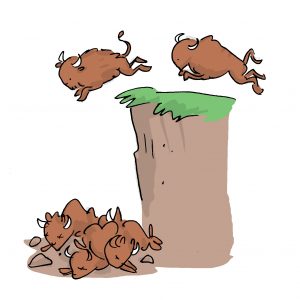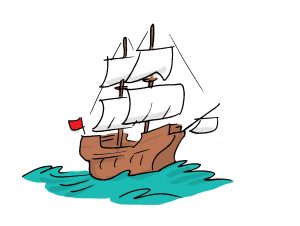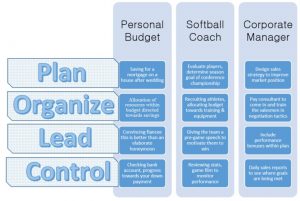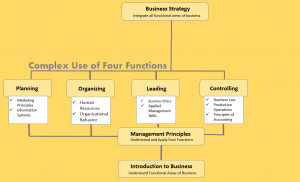1 Introduction to Management
Learning Objectives
The purpose of this chapter is to:
1) Give you a basic understanding of management and its importance
2) Provide a foundation of the managerial functions of planning, organizing, leading, and controlling
Introduction to Management
Management is not a hard science. Unlike chemistry or algebra where a right answer (often) exists, management is fluid, and subjective, and there are divergent perspectives on how to employ its principles. But what exactly is management? Most scholars have variations of the same definition that include a utilization of resources to achieve a goal. Lussier (2021) defines a manager as “the individual responsible for achieving organizational objectives through efficient and effective utilization of resources” (p. 3). The problem with this definition is that it implies that a manager has to be both efficient and effective, which eliminates the possibility of having a bad manager. Each of us can probably contradict this definition by providing an example from our personal past. However, this definition contains the basic elements of using resources to pursue goals.
An early management scholar, Mary P. Follett characterized management as “the art of getting things done through the efforts of other people” (Graham, 1995). This definition implies both pursuing goals (getting things done) and utilizing resources (predominantly through people). However, this too is missing an element, that of the organizational context. An important consideration for understanding management is that the term organization simply refers to “a collection of people working together to achieve a common purpose” (Shermerhorn, 2013, p. 11). This means an organization could be anything from your high school volleyball team to church or a corporation. Including the term “organization” in the definition leaves open the possibility that management can be practiced in each of these settings, and broadens our use of the term management. A comprehensive definition for management then, would be the pursuit of organizational goals through the use of organizational resources (Bateman & Snell, 2013). Pursuit implies a chance of failure and organizational gives us a context. This begs the question – how can we become effective at the pursuit of goals, or become more efficient in our use of organizational resources? Being good at management requires an immense focus on both of these ends, and we can achieve this through the process of the planning, organizing, leading, and controlling functions of management. These functions serve as the basis for the rest of the textbook because they are the essential tools we use to manage organizations. Most of the context and examples for this book focus on the corporate use of management. However, you should meet the concepts where you are in your professional or academic career – apply the principles to the context of your life, master the four functions for what you are doing now so that you can scale them to much bigger managerial endeavors later.
Management is not New
A broad understanding of management as resource utilization focused on a goal gives us a wide scope of situations and contexts in which to practice it. For example, the Crow Indians employed a complex strategy to harvest an entire herd of buffalo by driving them off a cliff. To funnel the herd to the lane leading up to the cliff they used a decoy (a hunter donned in a buffalo calf robe imitating a lost calf), incense to smoke them towards the lane, or rock piles to guide them to the lane (Nathan, 2018). If we apply the basic principles of management in this context we can see these hunters used resources (rocks, incense, knowledge and tradition) to pursue a goal (procurement of food, tools, and clothing the bison afforded them).

The Spanish Empire constructed the first global supply chain the world had ever seen once they discovered the surfeit of precious elements such as gold, silver, and mercury in North and South America (Aho & Lloyd, 2019).  Mule trains transported these treasures across mountain passes and jungles wherein war galleons then filled their holds. These fleets returned to Spain traversing the natural elements (tempests and shoals) while defending against state enemies (pirates).
Mule trains transported these treasures across mountain passes and jungles wherein war galleons then filled their holds. These fleets returned to Spain traversing the natural elements (tempests and shoals) while defending against state enemies (pirates).
At its core, this imperial supply chain used the same approach to achieve success that a teenager might use in a playing video games. If he rallys his friends after school in a game of Call of Duty to defeat their online opponents, he might also be considered a manager. He uses his experience and knowledge of gameplay as well as weaponry within the game to pursue his goal of competitive domination.
These examples demonstrate that management is multifarious, and not at all a recent phenomenon. Yet, when we hear the term management, most of us probably conjure an image something like that of a corporate vice president implementing a marketing strategy to meet quarterly sales goals. The irony is that the corporate manager is utilizing the same tools as those of the native hunter, Spanish fleet admiral, and sophomore gamer. Management is both universal and ubiquitous in that we all use variations of its elements.
The Four Functions of Management
The management process by which we pursue goals includes planning, organizing, leading, and controlling. These are “the how” a manager pursues organizational goals, and are universally known as the four functions of management. They stem from the work of a French mining administrator, Henri Fayol, who first identified management as a practice that could be improved through the use of five functions – planning, organizing, commanding, coordinating, and controlling. Since he published his work in 1916, we have decided that leading people through motivation and incentivization works much better than telling them what to do (e.g. commanding and coordinating). We use the term leading instead of these practices. Chapter 2 on the history of management will provide some insights regarding this change. Nonetheless, he gave us a place from which to start.
Even if you have never stepped foot in a corporate office, or held the title of manager at your local Dairy Queen, you have no less used the functions of management in your personal pursuits. A relevant example would be the process by which you manage your personal budget.
Reflection: Are you already a manager?
Think about your personal or family budget for a moment, and answer the following questions:
1) Do you have your budget written down somewhere, or in an excel spreadsheet?
2) What are your financial goals?
3) How much do you put in savings, charity, and monthly expenses?
4) Where does your money come from (a job, your parents, a hobby, your spouse)?
5) If you have a budget shortfall during the month, what do you do?
6) How do you keep track of expenses to ensure your bank account remains in the black?
If you answered yes to question #1, then you are already engaged in the management function of planning. You know where your money is being spent. The same holds true for your financial goals. If you want to leave college debt free, save for a down payment on a house, or go on an unforgettable spring break trip, you have defined your organizational objective! Where you put your money is a function of how you manage your resources. This organizing function is presumably in line with your financial goals. For example, if you want to save for a down payment, you need to actually allocate your resources (income) to a savings account. Moreover, where your money comes from is also the source of your organizational resources. A budget shortfall might require you to employ the leading function of management. The essence of leading is motivating other people to align with your plan. What do you do if you need to pay bills, but don’t have the money? Perhaps you ask your parents for a loan (need to sell this idea to them), or you might need to negotiate with a co-worker to let you take on extra shifts (show them what’s in it for them in return), or it might be the reality that you need to sell something to make ends meet by selling something (in which case selling requires you to inspire someone else to see value in what you are selling). Leading might also entail convincing someone else in your circle to get on board with your gameplan (like a spouse, or sibling). Finally, keeping track of your expenses to ensure solvency and pace with your goals is the core of the controlling function. Do you keep receipts and check them against your online account expenses? Do you update your spreadsheet after your bill automatically debits from your account? Do you get an email notifying you have a low balance and are in risk of overdraft charges? Each of these methods are ways to monitor your progress and decide if you need to make a change (short term or long term).
If you reflect on this example of your personal budget, or you worked to achieve a personal or team goal, you will likely conclude that you are already a manager. This wide application of managerial thinking means that if you can master its principles on your personal scale, you can then amplify its use when you need to use it on a large scale. Get good at leading your class project, organizing your club fundraiser, or helping your team win a conference championship, and you will later be able to magnify the scale to lead a marketing department, or corporate merger, and even diplomatic negotiations as a prime minister.
Mastering the four functions will allow you to apply the function of planning on a more complex stage such as evaluating the internal and external environments of your organization. Using this analysis you can create an effective game plan to formulate a sustainable competitive advantage. Developing an organizing skillset will allow you to propose a structure for your team that incorporates cross functional members and ways of thinking. It will allow you to identify and recommend resources needed to pursue your plan. Honing your leading skillset will afford you the capability to motivate your organizational stakeholders to partake in your strategy, and force you to consider the ethical implications of your actions. Finally, implementing effective controlling allows you to check progress towards your goals and to recommend changes if you need to get on track.
Planning
Planning is the systematic process of making decisions about goals and activities the organization will pursue (Bateman & Snell, 2013). To make a decision about the direction of an organization, the planning phase must begin with analyzing the environment. Without a solid understanding of the context, the manager would have no basis to provide future direction. The context gives a manager a point of reference for improvement, opportunity, and learning from past mistakes. For this reason, the planning function should begin with analysis. This analysis should consider both the internal factors such as culture, values, and performance of team members as well as the external factors such as competitive environment, legal regulations, economy, technology, social values, and demographics.
The second component of planning is to use this analysis of the environment to build goals, activities, and objectives. For a major organization this might be the vision and mission statement of the organization. For a smaller organization this could be a year end, or season end goal. Some consider planning that point in your day or month that you step away from your desk, and think about the direction of your organization. This requires you to reflect on your organization’s past, and determine how that impacts the direction going forward.

Organizing
Organizing is the process of assembling and assigning the human, financial, physical, informational, and other resources needed to achieve goals (Bateman & Snell, 2013). The core of the organizing function is leveraging the resources to align with the determined goals. Organizing human resources means first of all attracting a labor force that can help you pursue your goal. Within the organization, managing the human element means assigning tasks, delegating authority, determining a structure and hierarchy. Organizing the financial resources equates to making sure your capital is being utilized to meet goals. If an organization decides they want to have a best-in-class customer service team, they better being willing to spend the money to attract people with the disposition towards serving others, and spend money on training, or a retreat to teach the agents the skillsets they need. Marshalling physical resources focuses on the effectiveness of where you place and how you use physical assets. An executive chef might re-arrange a kitchen to improve process flow, food quality, or mitigate safety risks for example. Informational resources implies a leveraging and disseminating the organization’s knowledge in meaningful ways to achieve goals. Connecting employees to how they contribute to the financial bottom line is a way of leveraging informational resources, as is using your company’s proprietary algorithm to predict stock prices or develop new products.
Leading
Leading is stimulating high performance by members of the organization (Bateman and Snell, 2013). This function is getting members of the organization on board with your plan.
Normally, this means connecting with direct reports or teammates on a personal level. Understanding what drives individuals within the team allows a manager to design strategies around motivating, incentivizing, mobilizing, and arousing a desire to contribute.
Imagine for a minute, that you analyzed the conditions of the organization, you determined a game plan to pursue and even directed resources to step in that direction. You have successfully implemented the planning and organizing functions. In this scenario, however, you did not give consideration to how your team or organization would be involved. Do they agree with your direction? Did they have input in the process? Do they feel valued as a team member? Do they understand their role in a successful outcome? All of these questions are answered by the degree to which a manager is engaged in the leading function.
Having personal conversations, designing a bonus structure, or giving a rousing speech might all be considered leading the organization.
Controlling
Control is installing processes to guide the team towards goals and monitoring performance towards goals and making changes to the plan as needed (Batemen & Snell, 2013). Control does not always mean limited what the organization can do by having a hand in everything. We might call this micro-managing, which is control in its extreme form. Healthy control processes involve putting systems in place to make sure your organization is on track to meet the goals you established in the planning process. Planning sets standards to compare against, and the control process is the dashboard that tells whether or not you are meeting the standard. For example, a grocery store might set a goal of reducing shrink (that’s product lost to shoplifting, damage). They decide that they want to reduce their shrink loss by 50%. To achieve this plan, they will have to dedicate resources (more employees to monitor, rearrange loading dock). You already recognize that step as the organizing function. We then incentivize our employees by designing a bonus structure – i.e. if we collectively meet the goal, each employee shares in the savings. If we stop there, we would have no way of knowing if we met the goal. The control process solves this for us. The last step in the grocery store manager’s managerial approach is to have each department head report their shrink loss at the end of the shift, and aggregate those in an excel spreadsheet. In this way, the manager can see if the rearrangement of the loading dock has reduced the number of damaged canned goods that was happening under the old arrangement. The manager can make changes if they see that shrink is not improving even after hiring a greeter at the entrance.
Monitoring performance is the first step in control. After see the progress towards goals, the next step is to make changes. In this way, the control process always leads a manager back to the planning phase of management. There are only two outcomes to the control process. You are making progress towards your goal, or you are digressing in your performance. If you reach your goal, you will need to set new goals, which is the planning function. If you are not progressing towards your goal, you need to analyze the environment and determine why not. In this way the management functions are related and highly dependent upon each other, especially control and planning.
To illustrate the application of the four functions of manager, consider the various contexts in Figure 1.1. Under the personal budget, an engaged couple has decided to save for a house after getting married. The softball coach must determine how to win a conference championship, and the corporate manager is working on a strategy to improve waning sales figures.
Figure 1.1 – The Functions of Management Applied

On the Importance of Studying Management
The purpose of this textbook is to provide you with firstly, a broad exploration of what management is – its elements and origins. Secondly, the purpose of this textbook is to provide you with a managerial framework you can utilize to practice management at any level of complexity. This framework emphasizes the four basic functions – planning, organizing, leading, and controlling. Most management textbooks include a wide variety of academic terms and concepts that take focus away from these four functions. Other textbooks will inundate the reader with descriptions of heuristics, focus on layers of management, or extraneous terms like the Shamrock organization that do not advance a practical understanding of management. We have designed this textbook with the four functions of management at the forefront because these elements are so critical to the foundation of everything you will do in the managerial context. This textbook provides a history of management and a chapter on ethics, but then focuses exclusively on the functions of management as the subject matter. At the completion of this textbook, you should be able to understand, recognize, and apply these four functions of management.
The four functions of management (plan, organize, lead, and control) serve as the foundation for everything else you will study in your business education. Mastering these tools at the most basic level, as well as the more sophisticated levels in classes you will take later, will best prepare you as a business professional (Dolechek et al, 2019).
Figure 1.2 – Management as the Foundation

Upon completion of a management principles course, you will progress towards the applications of the four functions of management in the upper level courses. For this reason, management principles serves as a pre-requisite for most other management courses. In marketing principles you will develop an understanding of how to analyze external conditions, and a course in information systems will help you design ways to collect more information to analyze. This is the core of the planning function. In human resources and organizational behavior, you will learn the dynamics of your ever-important resource of human labor, the organizing function. In business ethics and applied management skills you work on understanding what drives people, and by association how to lead them based on that understanding. Grasping business law and production operations will give you a deeper understanding of how to monitor progress (to meet legal compliance and to test production quality for example). The entire discipline of accounting is a managerial function of control. Constructing financial statements is done for the sole purpose of determining the performance of you organization so that you can make future decisions. The capstone course of a business program is the business strategy class. In this course, students are given an opportunity to demonstrate mastery of the four functions by including all of the functional areas of business in their decision making.
A Whale of an Example
You are the city manager of a coastal Oregon city. On a quiet, rainy Tuesday, you walk into your office and put the coffee on. As you take your first sip, your administrative assistant forwards you a phone call from the parks and rec manager. “We’ve got a problem down here on the beach. The tide just left a dead humpback whale on our beach.” What do you do? What. Do. You. Do?? Now, there are several options to dealing with the dead whale. Consider the following questions:
- 1) What is your strategy for dealing with this problem? (Plan)
- 2) What resources do you need to follow your strategy? (Organize)
- 3) What stakeholders do you need to get on-board? (Lead)
- 4) What steps can you take to make sure your plan is proceeding as you planned it? (Control)

There are a handful of strategies we might naturally gravitate towards. The feasibility of each strategy depends on how well you employ the functions of management.
Tow the whale back to sea – A crane, tug boat, and tow cable are needed. Who might you need to include in this gameplan? The coast guard might need to be involved to discuss any pertinent regulations. A marine captain that can tell you about tides so that you can time your extraction, and insights about currents to indicate how far out you need to haul the whale once its buoyant. Should you allow a marine biologist to provide advice on what sort of ecological impact this might have (like bring in unwanted sharks or seals). How can you be sure the tow cable has enough tinsel strength to haul a bloated whale on a high friction surface like wet sand? Does the crane have the capacity to move the carcass into position to be hauled? If the whale is decaying, will the tow cable just pull through the rotten flesh?
Cut the whale up, haul it to the dump – You will need a forklift, semi-truck, and chainsaw. The first consideration here would be the logistics of pursuing this strategy. You will need to find a truck with the towing capacity to haul large chunks of the carcass off the beach. Can you ensure the weight of a loaded semi would not sink into the wet sand? How much does a semi-loaded with a whale carcass weight? You may also need to contact the county roads manager to determine if there are any bridges between the beach and the dump that have weight restrictions. What sort of protective equipment would you need for the men slicing through the whale with chainsaws? There are a few control processes that need to be put in place for this strategy to work.
Celebrate the whale – The objective of the city manager is to “deal with” the dead whale. For most, this would mean remove it somehow. For others, this might be a chance to celebrate the occasion, and establishing the experience in the culture and history of the town. To celebrate the whale, the city manager can hold a competition like car dealers do to promote their cars – have contestants place their hand on the whale and the last person to withstand touching the grotesque, slimy, and malodorous creature, somehow wins a major prize. This would require a sponsor to donate a prize (a car, a vacation) and the town can celebrate the occasion annually. If the goal is to appease the community from the existence of the whale and its stench, celebration is one strategy to pursue that end. You would need to include a biologist to determine if leaving the whale to decay after the festival would attract scavengers, and a water chemist to determine if a decaying whale creates toxicity problems for beach goers.
Blow it up! – The kid in most of us choose this option. Definitely. You might need to check with state officials to see what the protocols are on this approach. The biggest question would be how much dynamite do you need to blow up a whale, or blow it into the ocean? In Oregon, one stakeholder group you might contact is a mining company or the Oregon national guard. Both of those groups have a lot of experience calculating explosive requirements. What are the safety protocols you need in place to make sure that no one is injured? Where will you be able to source enough explosives to achieve this goal?
Use of the four functions
Each of these scenarios contain some far-fetched elements. But asking the right questions is paramount to turning any of these into a feasible strategy. You first need to decide a path, then determine your resources before getting stakeholder groups on board. For a high-risk situation like most of these solutions call for, you need to put control mechanisms in place to mitigate your risks. If you type “Oregon’s exploding whale” you can see what has become the most-watching news broadcast of all time. It shows you what happens when a city manager does not successfully navigate the situation using all four functions of management.
Critical Thinking Questions
How are the four functions of management related?
Which is the most important function of management?
Choose a historical event prior to the year 2000. Analyze the leader’s use of the four functions of management during that event.
How to Answer the Critical Thinking Questions
For each of these answers you should provide three elements.
- General Answer. Give a general response to what the question is asking, or make your argument to what the question is asking.
- Outside Resource. Provide a quotation from a source outside of this textbook. This can be an academic article, news story, or popular press. This should be something that supports your argument. Use the sandwich technique explained below and cite your source in APA in text and then a list of full text citations at the end of the homework assignment of all three sources used.
- Personal Story. Provide a personal story that illustrates the point as well. This should be a personal experience you had, and not a hypothetical. Talk about a time from your personal, professional, family, or school life. Use the sandwich technique for this as well, which is explained below.
Use the sandwich technique:
For the outside resource and the personal story you should use the sandwich technique. Good writing is not just about how to include these materials, but about how to make them flow into what you are saying and really support your argument. The sandwich technique allows us to do that. It goes like this:

Step 1: Provide a sentence that sets up your outside resource by answering who, what, when, or where this source is referring to.
Step 2: Provide the quoted material or story.
Step 3: Tell the reader why this is relevant to the argument you are making.
EXAMPLE: Let me provide an example of homework expectations using the type of question you might see in a critical thinking question at the end of the chapter. Each of the answers you provide should be this thorough.
Question: Explain why it is important to study management.
Answer:
Management is important to study because it serves as the foundation for all other areas of business. The four functions can be used in other business areas such as accounting, marketing, operations management and human resources. All of the areas of business need people who know how to make a plan and allocate resources. All of the areas of business need people who know how to motivate others, and to make sure they are on track for their organization’s goals. For this reason, improving our mastery of management will make us more effective at whichever role we are in. A good example of this foundation comes from research conducted on accounting firms in Romania. Wang and Huynh (2014) found that accounting managers who embraced both managerial best practices and had the technical skills needed for accounting improved the organizational outcomes of their firms. These findings suggest that business professionals need managerial skills to supplement the day-to-day roles they have.
As I reflect on management as a foundational discipline, I remember how my high school baseball coach approached our team after a losing season. We were not a good team because we did not have fundamentals of how to grip a baseball, how to stand in the batter’s box, or how to field a ground ball. That next year, he taught us all of these fundamentals and we won a lot of games. It seems to me that learning fundamentals of management can have the same impact. Being able to execute the four functions of management allows us to get better at how we approach marketing a new product, or improving operations processes.
Wang, D., & Huynh, Q. (2014). Linkages among corporate governance, management accounting practice and organizational performance: Evidence from a Southeast Asian country. Romanian Economic and Business Review, 9(1), 63-81.
Chapter References
Aho O.W., Lloyd R.A. (2019) The Origins of Robust Supply Chain Management and Logistics in the Caribbean: Spanish Silver and Gold in the New World (1492–1700). In:
Bowden B., McMurray A. (eds) The Palgrave Handbook of Management History. Palgrave Macmillan: London, UK.
Bateman, T., & Snell, S. (2013). M: Management (3rd ed). McGraw Hill / Irwin: New York, NY
Dolechek, R., Lippert, T., Vengrouskie, E. F., & Lloyd, R. A. (2019). Solving a whale of a problem: Introducing the four functions of management in a management principles course. International Forum of Teaching Studies, 15(2), 29-35.
Fayol, H. (1949). General and Industrial Management. Sir Isaac Pitman & Sons Ltd: London, U.K.
Graham, P. (1995). Mary Parker Follett: Prophet of Management. Harvard Business School Press: Boston, MA.
Lussier, R. (2021). Management Fundamentals: Concepts, Applications, Skill Development. (9th Ed). Sage Publications: Thousand Oaks, CA.
Nathan, R. (2018). The Grapevine Creek Buffalo Jump Complex: Interdisciplinary Research on the Crow Reservation, Montana (Doctor of Anthropology, dissertation). Indiana University.
Shermerhorn, J. (2013). Management (12th Ed). Wiley and Sons: Hoboken, NJ

